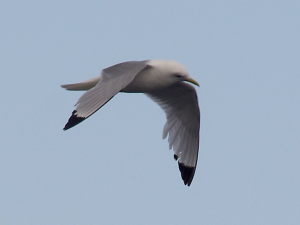


In Nottinghamshire the Kittiwake, being an almost entirely oceanic bird in winter, is an occasional visitor, almost always passing through on spring passage and usually in March. The "Atlas of Wintering Birds in Britain and Ireland {1986}" says that the older birds return to their breeding sites first but the younger ones (the ones more likely to stray) do not arrive until April.
Sterland describes its status in the "Descriptive list of the birds of Nottinghamshire {1879}" as not uncommon and often seen far from water in the late–mid nineteenth century. Interestingly F. B. Whitlock described Kittiwakes as almost as common as Black-headed Gulls in Derbyshire in the late nineteenth century.
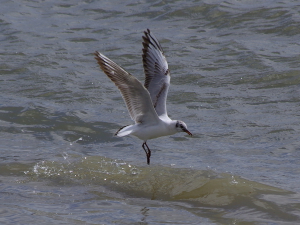
The Black-headed Gull is a very common winter visitor and passage migrant in Nottinghamshire. Numbers can reach several thousands at roosts such as Hoveringham. Most of Nottinghamshire's wintering Black-headed Gulls come from the Baltic area. It breeds in varying numbers at Lound and Attenborough and maybe other places.
Sterland in the "Descriptive list of the birds of Nottinghamshire {1879}" regarded it as a constant visitor on the Trent at various times of the year, and sometimes in small parties and Whitaker only gives one record in the same book. How times have changed!
In winter the Black-headed Gull feds widely throughout Nottinghamshire, in fields (both grazing and arable), rubbish tips and ponds and lakes where humans are ‘feeding the ducks’.
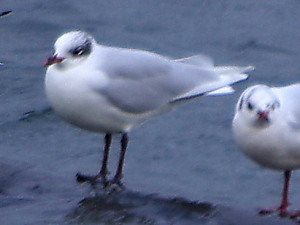
The Mediterranean Gull was first seen in Nottinghamshire in 1971, since then it has increased in presence so that 20 plus are seen every year nowadays, almost exclusively in winter. This reflects the increasing numbers on the English south coast.
Mainly seen at the big Nottinghamshire gull roosts in places such as Hoveringham and Holme Pierrepont. Sometimes loafs at other gull sites like Attenborough and Netherfield.
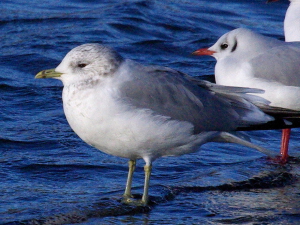
The Common Gull reaches numbers of a few hundred at the roosts in Hoveringham and Lound in the winter months. It has bred in Nottinghamshire in the recent past. In the nineteenth century Sterland in the "Descriptive list of the birds of Nottinghamshire {1879}" wrote that the Common Gull is very abundant during the winter season, appearing in large flocks, but is less frequent in summer. I have seen many at a time following the plough like rooks …
In the daytime feeds usually on earthworms in fields. The sandy and clay soils which cover much of Nottinghamshire contains less earthworms and so reduce the attractiveness to this species in the county.
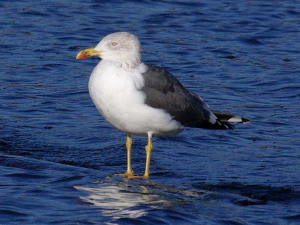
Lesser Black-backed Gulls are a common passage migrant, lingering more in the autumn than in spring. Some birds winter in Nottinghamshire – around a few dozen. They can be found in Netherfield Lagoons, Kilvington quarry, Hoveringham and Lound. In the nineteenth century records (or shootings) were few and far between, since the mid–1950s numbers have increased many times.
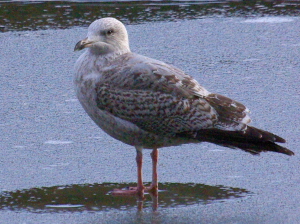
Herring Gulls in Nottinghamshire are considered a common winter visitor and passage migrant with numbers reaching a few thousand at the Hoveringham roost. As much as 15% of the Herring Gulls wintering in eastern England may be from north Scandinavia (PI Stanley {Bird Study 28:}) and (J C Coulson, {Ornis Scand. 15:}).
Sterland in the Descriptive list of the birds of Nottinghamshire {1879} noted that they were frequently seen along the Trent.
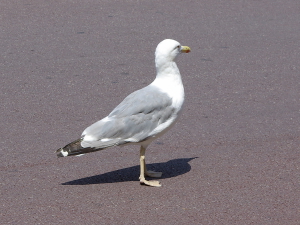
The Yellow-legged Gull is an uncommon visitor to Nottinghamshire mainly in autumn and winter. The birds appear at the usual sites such as Hoveringham, Kilvington, Netherfield and Lound
The Yellow-legged Gull was originally classed as the south-west European form of the Herring Gull. It has gradually spread north from there in the latter part of the twentieth century.
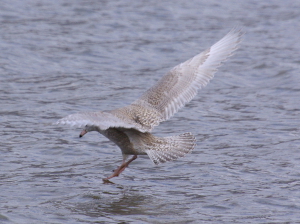
A scarce winter visitor to Nottinghamshire with six to ten birds recorded a year, the Glaucous Gull is mainly found at the large gull roosts. Usually the birds are biscuit-coloured first winter birds.
Sterland mentions in the Descriptive list of the birds of Nottinghamshire {1879} that two birds were shot on the river Trent by Beeston Weir in 1872.
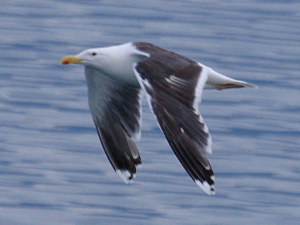
A fairly common winter visitor, rare in the summer months, the Great Black-backed Gull is the largest gull to visit Nottinghamshire. Numbers can reach a couple of thousand at the Hoveringham roost in winter. The birds wintering in Nottinghamshire probably come from Norway. From ringing recoveries, the Greater Black-backed Gulls breeding in the west and north of Britain does not appear to wander eastwards in winter.
Greater Black-backed Gulls make a lot of use of inland landfill refuse sites, which with their increased breeding numbers in the twentieth century make them commoner in Nottinghamshire than in the nineteeth century.
Any criticisms, corrections or comments to the author Derek Huskisson

This work is licensed under a Creative Commons Attribution-Noncommercial-Share Alike 2.0 UK: England & Wales License.